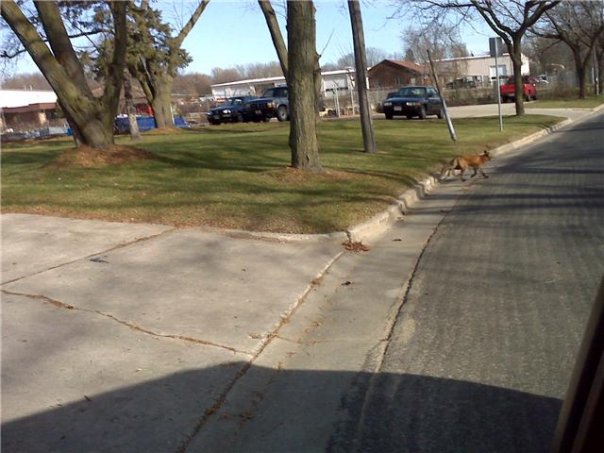I have written many times about how amazing I think it is that wildlife can thrive in urban settings. In my industrial park I have seen all types of crazy things that seem certainly out of place. This time of year the geese show up, migrating from the north. We are near several bodies of water and I think they use this area to take a break from flying.
I have seen woodchucks, skunks, tons of rabbits, squirrels, racoons, coyotes, deer, ducks (etc.) and just last week a couple more (big photos under the fold).
This is a baby red-tailed hawk. GREAT rodent control. He is sitting on top of my eco-friendly H3. We have these on our farm property. Hopefully this guy will grow up to be as big as those – I would guess the full grown ones that I have seen are about three times this size. I absolutely love birds of prey.

My wife needed to come to the ‘hood the other day and snapped this photo – this is right around the corner from my workplace (again, in the middle of an industrial park). It is a giant red fox.

We have these in my residential neighborhood as well. I would be interested to hear of wildlife that you have seen that seems out of place.
Cross posted at LITGM.
We regularly see deer, all kinds of birds, rabbits and fox at the office.
Last year I was taking a mental health break in the parking lot, strolling back and forth. A squirrel broke cover, just about ran over my feet, hurled itself at a tree and sprinted up the trunk. On it’s heels was a fox.
B’rer Fox didn’t see me until he was within touching distance. He slammed on the brakes. Looked me in the eye. Warily turned and trotted back into the brush.
I love that hawk picture on your hummer. Also your wife must have been pretty quick to snap that fox, they move fast and are pretty crafty. I never can seem to get my camera out quick enough to get those types of good shots.
http://laughingsquid.com/raccoons-line-up-to-ride-san-francisco-muni-bus/
Great photo although I have a feeling that the bus driver is feeding those filthy creatures.
All birds are pretty much fully grown once they fledge from the nest. They don’t triple in size over the course of a year or anything like that.
If this bird is demonstrably smaller (by a factor of three as you suggest) from the red tails at your farm it could be a Broadwinged Hawk or possible an immature Cooper’s Hawk. Hard to tell from the picture.
The Meatriarchy: Thanks, I learn something new every day! The ones at my farm property are definitely red tails and are much larger than this one so I am glad to hear that other species are flourishing around here.
Dan, I think your hawk is a sharp-shinned hawk….they only get about 14″ and are fairly common.
http://www.fcps.edu/…/ecology/sharp-shinnedhawk.htm
I was at my son’s wedding in Berkley over Labor Day and stayed at the Berkley Marina hotel (Can’t recall the brand). My youngest daughter (19) and I were taking a walk about midnight before going to bed. We walked out the front of the hotel beneath the Porte Cochere and there was a trash barrel sitting by one of the pillars. It had one of those tops with a smaller hole for the trash. As we walked up to it, a raccoon came boiling out the hole and took off. Then another one, and another one and another. There were four raccoons, all pretty good size, inside that barrel which was smaller than the typical garbage can. They looked like clowns getting out of a tiny car at the circus.
Michael Kennedy – securing waste and garbage is the first thing that is needed to keep the nasties such as raccoons, coyotes, feral cats, opossums, etc. away from any property. I was appalled to see that bus driver in the photo above feeding those wild animals. Terrible stuff, conditioning them like that and nothing of good ever comes of it.
Mike Doughty – bum link, try again.
Back in 2005 Rush Limbaugh noted the spotted owl’s ability to adapt to human retail chain proliferation. The original is available to subscribers only by this time, but I blogged this excerpt:
“Well, lo and behold, they tagged a bunch of them and they found a couple of them living in a Kmart sign, the red K in a Kmart sign. Spotted owl! And the Kmart sign, I hate to tell you, is not a tree. I don’t know if you can find any Kmart signs anymore, or as many, but these two spotted owls found them.”
http://alankhenderson.blogspot.com/2005_04_01_archive.html#111418378196031174
Their ability to adapt to Walmart has yet to be documented.
Approximately 10 years ago, an environmental impact statement had to be written to determine if a new bridge across the Mississippi River in Sartell,MN would disrupt the sandhill crane rookery that was present on an island midway across the river that the bridge would span. Much hand wringing occurred due to the protected sandhill crane breeding grounds that possibly would be impacted. The bridge was built and the crane population has continued to increase despite thousands of vehicles passing by the rookery within a couple hundred yards of the rookery each day…animals adapt and are much less bothered by humans than the other way around!